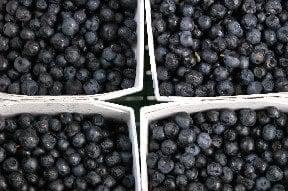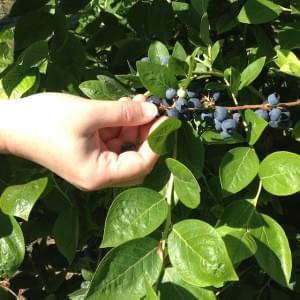Vaccinium mytillus and other species, a.k.a. Wineberry, Dyeberry and Whortleberry
With diabetes rates spiraling, bilberry is America’s new best friend. The research from around the globe proves that bilberry and its cousins can reduce blood sugar when taken regularly. A 2009 study from Canada’s University of Montreal revealed that even in a short 6 day time period, the properties in members of this popular genus improved glucose transport by 15-20 percent. This is the kind of friend sufferers of adult onset diabetes need.
Bilberry belongs to a complex genus containing more than 450 species. Species include blueberry, cranberry and huckleberries. Although bilberry has the most documented research behind its name, traditional healers from around the globe use their native Vaccinium species similarly.
Bilberry is used to rapidly heal eye tissue. Glaucoma, macular degeneration and cataracts all respond to bilberry’s medicinal touch. The combination of antioxidants and constituents deep within the pigment that gives bilberry its rich blue color protect and heal eye tissue.
Medicinal Properties
 Much has been made of bilberries anthocyanidin content and for good reason. They are extremely active in the body. They strengthen and rebuild capillary walls, reduce angina, and stabilize the collagen that connects tissue to the bone. The Linus Pauling Institute has dedicated a great deal of research to understanding how these pigments protect and heal body tissue.
Much has been made of bilberries anthocyanidin content and for good reason. They are extremely active in the body. They strengthen and rebuild capillary walls, reduce angina, and stabilize the collagen that connects tissue to the bone. The Linus Pauling Institute has dedicated a great deal of research to understanding how these pigments protect and heal body tissue.
The anthocyanidin content in bilberries are the focus of research on preventing and treating ulcers and diabetes. It works similarly to insulin in the digestive system, which allows patients better control of their blood sugar. A gulp of bilberry tincture in a splash of water is the quickest way to balance your blood sugar. Many diabetic patients keep a bottle of bilberry tincture in their first aid kit for just such emergencies.
Anthocyanidin pigment also increases stomach mucus, which heals ulcers and allows more complete breakdown of food. Although alcohol is not recommended for ulcers, diluting the tincture in warm water before drinking it will help evaporate the alcohol content while still preserving the strength of bilberry’s medicinal constituents.
Anthocyanidin is most noted for its effect on vision. It regenerates the light-sensitive pigment in the eye called rhodospin. The evidence that it rebuilds damaged retinas is equally compelling. Couple this with bilberry’s high antioxidant list and you have a recipe for healthy eyesight. There is also evidence these pigments hold anti-microbial properties.
Bilberry doubles its healing power with a vast list of antioxidants including: phenolic compounds, hydroxycinnamic acids, flavonols, catechins, vitamin A, vitamin C and proanthocyanidins. These chemicals hunt and trap free radicals that are responsible for cell damage. They protect the body from premature aging due to stress, disease and injury.
The blue color of bilberry proudly displays its antibiotic properties. The aniline dyes have a remarkable attraction to bacteria. As Dr. Rudolf Fritz Weiss explains in his classic text simply titled Herbal Medicine, these pigments penetrate living cells as it stains them. The staining process damages the bacteria thus inhibiting their growth.
The abundance of tannins in both the leaf and the berry are the power behind bilberry’s treatment of intestinal problems such as diarrhea. Tannins work as an astringent on the intestinal wall to keep them from producing watery stools. The amount of tannin in bilberry leaf is higher than that of the berry, which can cause stomach upset. The berry balances the tannin content in the leaf. This is why bilberry leaf is usually blended with the berry.
Conditions Best Helped by Bilberry
- Diarrhea
- Eye Disorders (glaucoma, macular degeneration and cataracts)
- Varicosities (hemorrhoids and varicose veins)
- Diabetes
- Gout, rheumatoid arthritis, and similar inflammatory conditions
- Peptic Ulcers
For more information on the conditions best helped by this herb, see the topics in Conditions.
List of Bilberry’s Medicinal Actions
Anti-diarrhea, antiulcerative, gastoprotective, anti-enemic, anti-bacterial, circulatory, nutritive and anti-inflammatory.
Medicinal Processing
Bilberry is a valuable herb to have in the medicine cabinet. Dried bilberries provide an excellent base for a tincture. Fresh bilberries have so much moisture the resulting tincture is watery and bland. A sweet alcohol base like brandy brings out bilberry’s natural flavors.
Bilberry vinegar is easy to make from start to finish in the course of a month. Add one cup of dried bilberries to one quart of apple cider vinegar. After 30 days, strain the fruit to enjoy the vinegar. A spoonful on salads or dashed over bread is a tasty way to increase antioxidants in the diet.
Bilberry syrup is a good way to introduce powerful antioxidants into even a fussy eater’s diet. Taken by the spoonful, stirred into tea or drizzled over pancakes – bilberry syrup is easy to make from either fresh or dried bilberries.
Bilberry tea is simply delicious. Allow a tablespoon of dried bilberries to steep in hot water for 10 minutes to get the full effect of the pigments and the flavor. Add cooled tea to your water bottle to enjoy all day.
For more information on basic herbal preparations, see the topics in Herbal How-to.
Gardening and Gathering
 Bilberry is a durable garden plant. All it requires is acidic soil, a little sun and plenty of water with good drainage. The bush is a perfect gift for a beginning gardener. It can be grown in containers or straight in the soil. Just keep it watered the first year and a two year-old start can produce a large crop of berries the very next year.
Bilberry is a durable garden plant. All it requires is acidic soil, a little sun and plenty of water with good drainage. The bush is a perfect gift for a beginning gardener. It can be grown in containers or straight in the soil. Just keep it watered the first year and a two year-old start can produce a large crop of berries the very next year.
Bilberries, like other species in the Vaccinium genus like blueberies, can tolerate partial shade as long as the soil is rich with compost. Don’t let these bushes dry out, but be careful they don’t get waterlogged either. Once the plant is established, do not disturb the roots. Vaccinium species have a complex relationship with the fungi in the soil. This connection allows them to increase their health and your berry yield.
If rhododendrons and azaleas grow well in your area, you are in luck. The soil they like is the same soil that bilberries like. Soil pH in the range of 5.3 – 6 is perfect for these plants. Try mulching with high acid pine needles in the fall to keep the soil just right.
Quick ID tips
Appearance: Bilberry is a perennial shrub that grows to about 16 inches in height. The leaves are waxy and oval in shape with sharp edges. The flowers are small and round and are visible as pink blossoms in the spring. These mature to white after pollination. The berries are distinctly spherical. They have a much less furled edge on the blossom end of the fruit which is obvious on blueberries.
Taste: Sweet and tart like a blueberry
Odor: Blueberry scented
Gathering Bilberries
 Gathering bilberries couldn’t be easier. There are no thorns to dodge, no high branches to climb and no stooping over low rows in the hot sun. The bushes are waist high to shoulder high, depending on the variety. The berries pop off in your hand with a gentle tug and a twist when they’re ripe.
Gathering bilberries couldn’t be easier. There are no thorns to dodge, no high branches to climb and no stooping over low rows in the hot sun. The bushes are waist high to shoulder high, depending on the variety. The berries pop off in your hand with a gentle tug and a twist when they’re ripe.
Harvest bilberries in summer. They will turn a deep purplish blue when they are ready for eating. Picking bilberries is best when accompanied by children. Kids are firm believers in taste testing bilberries to be sure they are ripe enough. Encourage this, it’s good for them. They consider berry picking to be a treasure hunt. They are right.
Using Bilberries to Care for Animals
Bilberries are good to add to help restore the health of omnivorous and vegetarian animals recovering from illnesses. The antioxidant value alone recharges their recovery system. The anti-inflammatory properties help ease their pain. Stir bilberries into their grain or feed. Most dogs will take a dropper full of tincture if it is added to their drinking water but I have never known a dog to refuse to eat a handful of bilberries.
Animals suffering from pathological eye conditions such as macular degeneration, should get bilberry tincture in doses according to their weight. Do not administer tincture without consulting with a veterinarian first. Try brewing bilberry tea and chilling it into an herbal ice cube to add to the drinking water of animals who are fussy eaters.
Household Formulas and Non-medicinal Uses
 Bilberries may be substituted for blueberries in any recipe. Muffins, tarts, cheesecakes, granola and waffles are the classic companions of bilberries. Add bilberry to yogurt as a delightful way to start the day. Citizens of the UK have enjoyed bilberries in their breakfast menu for centuries. Their bilberry jam recipes have been passed from generation to generation.
Bilberries may be substituted for blueberries in any recipe. Muffins, tarts, cheesecakes, granola and waffles are the classic companions of bilberries. Add bilberry to yogurt as a delightful way to start the day. Citizens of the UK have enjoyed bilberries in their breakfast menu for centuries. Their bilberry jam recipes have been passed from generation to generation.
Vintners have produced delicious bilberry cordials, wines, and brandies. Those who want to enjoy bilberries without the alcohol can prepare bilberry juice, smoothies and spritzers.
For more recipes and ideas for using bilberry, see the topics in Recipes.
Cautions for Bilberry
There are a few known cautions for bilberry tincture. Pregnant or nursing women should only use bilberries under the advice of a qualified health specialist as it can interfere with the absorption of iron if taken in immoderate amounts. Patients taking anticoagulants such as warfarin or those with bleeding disorders should be cautious about taking bilberry leaf. Bilberry fruit is a better choice for this condition. Consult your doctor before adding this or any herbal supplements to a warfarin controlled diet. Diabetic patients should monitor their blood sugar to prevent hypoglycemia. Discontinue use of bilberries if allergic reactions occur.






